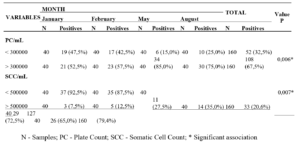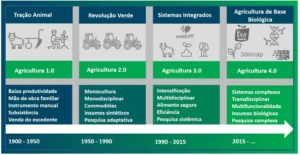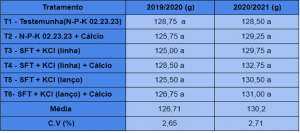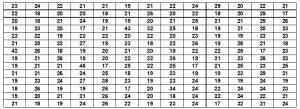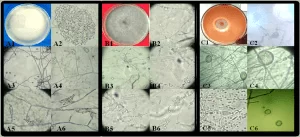SOUZA, Pablo Porto [1]
SOUZA, Pablo Porto. Influence of Organic and Mineral Fertilizer on early development of culture-Italian Zucchini (Cucurbita pepo). Multidisciplinary Core scientific journal of knowledge. 03 year, Ed. 06, vol. 02, pp. 133-145, June 2018. ISSN:2448-0959
Summary
The experiment was deployed in order to verify the effect of mineral and organic fertilizer in early development in the culture of Italian Zucchini (Cucurbita pepo l.). The work was conducted in the condition field in the Spotted Large Farm trial located in the municipality of Baianópolis-Ba. The experimental design used was randomized blocks, in which four treatments were established, consisting of T1: Witness; T2: mineral Fertilization, using the formula 4-14-8, being applied 18 grams per grave; T3: cow manure 200 g. Cova-¹; T4:125 g. ¹ grave of Aviary. The area used was 42 m ², with 1.0 x 0.80 m spacing, and the plants were arranged in two rows, each with two plants, four plants per plot. The fertilization was done ten days before planting as established treatments. The evaluation of the average values of number of sheets (NC), plant height (AP), stem diameter (DC), fresh pasta (MF). The greatest comparative value found for the variable AP, during the 30 days of evaluation, were the treatments they received the organic fertilizing, T3 and T4 treatment. The highest average values for the culm diameter (mm) achieved was the organic treatment in particular the three treatment that had average value of 7.5 mm. Averages obtained for the leaf number showed that plants that were held the organic fertilizing provided amount of upper leaves to treatments that received no fertilizer type (T1) and those who have received mineral fertilization (T2). The results for the fresh pasta (MF) revealed that the use of cow manure as an organic fertilizer provided a greater increase when compared with the other treatments. The difference between the 3 and 1 treatment treatment was high, where you can examine the treatment obtained 9, 9 g more than the witness. With the results obtained can analyze the use of organic fertilizer was the treatment who excelled in relation to the growth of Italian Zucchini, promoting an increase in your productive potential.
Key words: Fertilization, Zucchini, development.
1. Introduction
The Cucurbit family has about 118 genera and 825 species, adapted to tropical and subtropical regions of both hemispheres. In this family, we can cite the pumpkins and morangas that belong to the genus Cucurbita (RIBEIRO, 2008).
Italian Zucchini (Cucurbita pepo l.), also known as Zucchini Bush, has upright growth, short stems and leaves mottled seeds. The root system is long and shallow with greater concentration on 20 cm soil layer. The fruits of Italian Zucchini are elongated and cylindrical, with a light green color with darker longitudinal striations (RIBEIRO, 2008). It is recommended the planting of Zucchini from September to February in cold winter, while in hot climates, planting can be done year-round (CONSTAT STATISTICAL CONSULTANTS, 2003).
The species Cucurbita pepo l. is a plant vulnerable to frosts, but it has a good tolerance to low temperatures. Temperature plays a big influence in germination and each species has a minimum temperature, maximum and optimum for germination (RIBEIRO, 2008). Ideal for the development of the Pumpkins is in the range of 20 to 27° c. Lower temperatures affect the production, and plants can even die at temperatures lower than 10° c. On the other hand, the high heat and the high moisture content can trigger the onset of diseases. The zucchini also require temperatures in the range of 22 to 25° C and do not support extended cold and strong (SANTOS et al., 2005).
The vegetables are considered nutrient-demanding, would require large amounts of nutrients in a short cycle so she get a good development (GOTO; TIVALLI, 1998).
One of the goals of the farm is to increase crop productivity. However, these increases should be compatible with the reduction in production costs. For this to happen, the cultural practices associated with the fertilization must be efficient (KANO et al., 2010).
In relation to fertilization is possible to infer to be achieved the expected productivity, as well as taking into account soil fertility where culture is being inserted. The calculation for liming and fertilization of soil should take account of the fertility of the soil and its nutrients (COSTA, 2006). For maximum efficiency in the alçassem nutrients system where he was employed, it is necessary to distribute in balance and in required amount (TOLEDO; MARCOS SON, 1997).
Chemical fertilizers are formed from inorganic compounds, with the most employees in agriculture due to the high content of nutrients, lower cost per unit of the item, less humidity and you get results faster.
On mineral fertilizers, chemical fertilizers applied in soil causing high productivity and instant grow, however the frequent applications of these fertilizers can affect both the nutritional quality of the food as the chemical characteristics of soil, in some situations leading to a breakdown of the productive potential of the soil (2006).
The fertilization with NPK aims to replenish the nutrients absorbed by plants to your development or to improve soil fertility. The application can be made with the mixture, as the 4-14-8 or NPK applying nutrients in isolation (OLIVEIRA, 1998)
The use of mineral fertilizers, in addition to modifying the pattern of growth and plant production, influences metabolic processes such as absorption and distribution of mineral ions (ROBSON; PITMAN 1983).
The vegetables in general are benefited by the use of organic fertilizers, both in productivity as in product quality achieved, being the most usual source cattle manure, especially in poor soils in organic matter (FILGUEIRA, 2000). Because they act as a powerful agent of soil conditioner, able to substantially improve many of its physical and chemical characteristics (FERREIRA et al., 1993).
Organic fertilizer is a product of vegetable origin, animal or agroindustrial that applied to the soil provides an elevation of your fertility, increase in productivity and quality of crops (TRANI et al., 2013). The animal manures, crop residues and green fertilizers constitute the main sources of organic fertilizers available (SBCS, 2004). The adoption of the use of organic matter has been linked with the change of physical properties of the soil and with the addition of nutrients to the system (KANG 1993).
The selection of organic residue to be applied is given regarding the availability of this, which can vary not only the region, but also to culture (KIEHL, 1985).
The application continues to cow manure causes significant elevation of pH that is related to the release of ammonia during decomposition your or possibly the presence of Ca and Mg from this residue, which neutralizes and displaces responsible elements by acidity, in the contents of the other elements in the layer of 0-20 cm in the ground, compared to areas without manure (GALVÃO et al., 2008). The dung features beneficial interactions with soil microorganisms, decreases the compression, increases your quality structure and stability of its aggregates, improves water infiltration, aeration and root penetration ( ANDREOLA et al., 2000).
With the increased use of organic residues in crops, it is possible to decrease, over the years, the application of mineral fertilizers and improved soil quality (less pollution of various natural resources), since organic waste Act also as the conditioners solo (SILVA, 2005).
The use of waste produced within a property may reduce production costs, such as the bed of the Aviary generated in the creation of birds that can be used as organic fertilizer (VILELA, 2009).
Second Primavessi (1982), the aviary, intensifies the cationic exchange capacity of the soil, increases the pH, reduces the content of exchangeable aluminum, raises the availability of nutrients and promotes plant health, to diversify the production of substances such as phenols, improving the physical, chemical and biological conditions of the soil.
The growing poultry waste generation is causing environmental impacts, because your production rate is greater than the rate of degradation; Therefore it is increasingly important to the need to reduce, recycle and reuse the waste produced in aviculture, with the intention of retrieving matter and energy (STRAUS; MARK, 1993).
The beneficial effects of poultry manure are compared with those of urea, due to rapid response and usually has a high rate of nutrients (SOUZA, 2007). The concentrations of N, P and K added in chicken manure are larger than other species of domestic animals, because your dry matter contains of 5 to 15% water, while other manures have the 65 85%. The manure waste contain solids and liquids in large majority is created with bird feed would lead to concentrated (TEDESCO et al., 2008).
This input normally contain high levels of phosphorus, potassium, calcium and magnesium, which makes an organic fertilizer with potential use in different cultures of agronomic importance (FARIDULLAH et al., 2008).
Even with the growth of growing pumpkins in Brazil in recent years, using, among other practices, the mineral and Organic fertilization, productivity, according to Makishima (1991), has been variable, requiring so fertilization and nutrition data ( REPORT, 1991).
Thus, the main objective of this work was to evaluate the influence of mineral fertilizer (npk 4-14-8) and organic (cow and avian bed) in the early development of the zucchini.
2. Development
Material and methods 2.1
The experiment was conducted the day 18/06/2017 to 23/07/2017 in the experimental area Spotted Large Farm located in the municipality of Baianópolis-Ba, with the following geographic coordinates: 12° 18 ' 53 "South Latitude and 44° 35 ' Longitude, with an altitude 59.29 of 668 m, with average annual precipitation of 1040 mm, with an average temperature of 24.9° C and with relative humidity between 65% to 68%.
According to soil analysis of the site was found a sandy soil, with pH 5.79; P = 7, 90 mg/dm ³ (too low); K = 89 mg/dm ³ (high); CA = 2, 30cmolc/l (top); Mg = 0, 70cmolc/l (low); Na = 10 ppm and organic matter 2.60% (m/v) (bass).
The experimental design used was randomized blocks, in which four treatments were established, consisting of T1: Witness; T2: mineral Fertilization, using the formula 4-14-8, being applied 18 grams per grave; T3: cow manure 200 g. Cova-¹; T4:125 g. ¹ grave of Aviary bed corresponding to the dose of the recommendation of the DOVES (1994), distributed in five repetitions. The area used was of 42 m ², with 1.0 x 0.80 m spacing, which were arranged in two rows, each with two plants, four plants per plot. The spacing used between plots was 0, 70 m. The method of propagation happened by sow manual which employed 3 to 4 seeds from Zucchini caserta by pit at a depth of 4 to 5 cm, the fertilization was done 10 days before the sow.
Eight days after the emergency was made the thinning to remove excess plants per grave, leaving only 1 plant per hole. Control of invasive plants happened manually and water supply occurred through conventional sprinkler irrigation system.
In each collection (10, 20:30 DAE) were evaluated characteristics of vegetative development of plants as plant height (cm), stem diameter (mm), number of sheets larger than 3 cm and the total fresh mass (grams). To determine the height was used a measuring tape 3 m extension steel, graduated in cm, measuring from the base of the soil to the most extended foil. To determine the diameter of the stem was used a caliper analog in steel, universal type, measured in the neck of the plant. After cutting, the phytomass of Zucchini, it was placed in paper bags and properly identified. Then she was taken for removal of their weights on precision analytical balance, which assessed the mass of fresh matter. The collected data were subjected to analysis of variance, and the means were compared by Tukey test at 5% probability, using the statistical program Sisvar.
3. Results and discussion
3.1 plant height (AP)
The data obtained concerning plant height (cm), depending on the different types of fertilization in Italian Zucchini-culture are exposed in the table 1. With respect to the applied treatments, it is observed that, when the averages were submitted to Tukey test to 5%, the same presented significant differences among themselves.
Table 1-average values for the height (cm) total of Zucchini-Italian plants subjected to organic and mineral fertilizer.
| Treatment plant height (cm) | ||
| T1 – (Witness) | 3, 5b | |
| T2-((4-14-8)) | 4, 2ab | |
| T3 – (Cow Manure) | 4, 4a | |
| T4 – (Avian) | 4, 4a | |
| CV (%) *: 12.1
Overall average: 4.1 DMS **: 0.95 |
||
* CV: coefficient of variation;
** DMS: minimum significant Difference;
Medium followed by the same letter doesn't differ from entering you by Tukey test at 5% probability
Despite having significant effects, the averages found in treatments were not very distant from each other, numerically speaking. The greatest comparative value found for the variable AP, during the 30 days of evaluation, were the treatments they received the organic fertilizing, T3 and T4 treatment. To compare these treatments with the control treatment, it may be noted that there was a difference of nearly 1 cm.
In a survey conducted by fields (2013), also confirmed the superiority of the treatments with organic matter on the treatment with mineral fertilizer (NPK). The average height of the plants from the organic fertilizer treatments surpassed significantly in 10.5% of NPK treatment. Lal et al. (2015), also found positive responses to the AP by using organic fertilizer. They report that, the plant height was influenced significantly by the quantities of organic fertilizer used, having a quadratic behavior, where the maximum value was obtained when using the maximum amount of fertilizer. According to them, this possibly could be linked directly to the increased availability of nutrients to the plant, favoring thus the height growth.
The organic material that can be made available through dungs, tends to increase the cationic exchange capacity of the soil, also works with power source for useful microbial, minimizes variations in soil reaction that can be caused by various causes, increases infiltration and water storage. Conditions the soil, giving a better structuring and airing that facilitate the development of the root system and helps in the supply of nutrients to the soil, making them available to plants and promoting a good development for the same ( MALAVOLTA et al., 2002).
3.2 culm Diameter
The use of different types of fertilization (Mineral and organic) in the production of Italian Zucchini-added positively (p < 0.05) in the culm diameter (mm) of these plants, as can be seen in table 2.
Table 2-mean values for the culm diameter (mm) total of Zucchini-Italian plants subjected to organic and mineral fertilizer.
| Culm Diameter treatments (mm) | ||
| T1 – (Witness) | 4, 4b | |
| T2-((4-14-8)) | 6, 6a | |
| T3 – (Cow Manure) | 7, 5a | |
| T4 – (Avian) | 6, 5a | |
| CV (%) *: 10.8
Overall average: 6.2 DMS **: 1.27 |
||
* CV: coefficient of variation;
** DMS: minimum significant Difference;
Medium followed by the same letter doesn't differ from entering you by Tukey test at 5% probability
When parsing the variable culm diameter Zucchini-Italian plants, it was observed that the only treatment that showed no elevated was exactly the treatment that did not receive any type of fertilization (T1). When comparing the T1 with the other treatments, the difference between them came to exceed 3 mm. Of treatments that received fertilizer, what stood out was the 3 treatment, that received cattle manure. The treatment T2 and T4 were on the same line.
Oliveira Júnior et al. (2009), to study the effect of different sources of organic fertilizers on culture of moringa, also noted that the largest thatched diameters were obtained in the treatments they received the application of cow manure. In addition, other studies also prove this beneficial effect and gradual organic fertilizing. According to Saad et al. (2012) the increase in the diameter of the stem of the plants happens, possibly due to the addition of organic matter in the soil, resulting in several beneficial effects as the improvement in the properties of the soil and thus increasing the supply of nutrients to plants .
And once again, some studies have shown the positive effect and gradual organic fertilizing. Walter et al. (2009), in studies where assessed residual and immediate effects of the use of Aviary, have obtained better productions obtained with mineral fertilization. The elevation of the concentration of soil organic matter is considered the main benefit of the agricultural use of organic waste, due to your contribution to the improvement in the chemical, physical and biological attributes of the soil (BERTON; Valadares, 1991).
3.3 number of sheets
The averages that were found and submitted to analysis of variance showed in its results, results which are set out in table 4 that the use of different fertilization on Zucchini-Italian production showed significant effects for the number of sheets.
Table 3-average values for the numbers of total leaves of Zucchini-Italian plants subjected to organic and mineral fertilizer.
| Number of treatments | ||
| T1 – (Witness) | 4, 4b | |
| T2-((4-14-8)) | 5, 3ab | |
| T3 – (Cow Manure) | 5, 9a | |
| T4 – (Avian) | 5, 6a | |
| CV (%) *: 14.68
Overall average: 5.2 DMS **: 1.43 |
||
* CV: coefficient of variation;
** DMS: minimum significant Difference;
Medium followed by the same letter doesn't differ from entering you by Tukey test at 5% probability
To the variable number of leaves, the results obtained for the different types of fertilizer used on Zucchini-Italian production (table 4) showed that the plants have received organic fertilizing, like cow manure (T3) and avian bed (T4) submitted amount of upper leaves to treatments that received no fertilizer type (T1) and those who have received mineral fertilization (T2).
Lima et al. (2001), studying the application of organic fertilizer and mineral fertilizer, in dwarf cashew plants-precocious, observed that the use of such fertilizers showed positive effects in the amount of leaves of plants. Already Manu (2008) reported that the best results were found in plants that received the organic fertilizing. Costa (2008) also found the best results with the use of goat manure, getting an average of 63.87 leaves.
3.4 total fresh mass
As well as the other variables, the total fresh mass also showed significant effects for the different evaluated parameters. This data can be given in the following table (table 4):
Table 4-average values regarding fresh mass total (grams) total of Zucchini-Italian plants subjected to organic and mineral fertilizer.
| Treatment fresh mass (grams) | ||
| T1 – (Witness) | 21, 7b | |
| T2-((4-14-8)) | 27, 3ab | |
| T3 – (Cow Manure) | 31, 6a | |
| T4 – (Avian) | 24, 0ab | |
| CV (%) *: 17.25
Overall average: 26.15 DMS **: 8.47 |
||
* CV: coefficient of variation;
** DMS: minimum significant Difference;
Medium followed by the same letter doesn't differ from entering you by Tukey test at 5% probability
The results found in this parameter showed that the use of cow manure as an organic fertilizer presented a greater increase when compared with the other treatments. The difference between the 3 and 1 treatment treatment was blatantly obvious, where you can observe (table 4) that the treatment obtained 9, 9 g more than the treatment 1.
Silva et al. (2016) reports on your work you, the largest total production of fresh bean-pod was achieved when using the fertilization via manure, this factor can be connected directly to the supply of nutrients present in the manure, cattle or goats . They present the advantage of providing the nutrients more quickly in soil solution, when given a suitable volume of irrigation water, with this, resulting in best response of culture and encouraging greater production, once the Association of the factors (organic fertilizer and irrigation water levels) maximize the relationship soil-water-plant, with this going on the biggest accumulation of phytomass.
This superiority of organic fertilizer was also observed in a work of Galbiatti et al. (2011), where he talks to, mineralization of organic matter potentiated the action of micro-organisms, and result in a better use of soil nutrients, and promote a greater nutritional balance of culture evaluated. According to Baqeti et al. (2011), increased organic matter present the ground through the application of manures, can greatly enhance the provision of nutrients to plants, as confirmed in works by other authors. The availability of these nutrients can come to meet the nutritional requirements of plants, in addition to contributing to the improvement of the water holding capacity of the soil in that function will decrease the frequency of irrigation by moderating the producer spending ( SILVA et al., 2016).
Conclusion
With the results achieved, it was possible to analyze the use of organic fertilizer, contributes in the vegetative growth of Italian Zucchini (Cucurbita pepo l.), promoting an increase in your productive potential. However, the chemical fertilizer can also be used, provided that your use is done rationally and without the application of pesticides that harm the environment.
References
ANDREOLA, F.et al. Cover of winter and the organic fertilizing and, or, mineral influencing the succession bean/corn. Brazilian Journal of soil science, Campinas, v. 24, n. 4, p. 867-874, 2000.
BERTON, R.S.; VALADARES, J.M. A. S. agricultural potential of the made up of urban waste in the State of São Paulo in Brazil. The Embrapa, v. 43, p. 87-93.1991.
BAQETI, l. et al. Organic potato fertilizer with cow manure in the municipality of hope-PB. Brazilian Horticulture. v. 42, n. 2, p. 482-487, 2011.
FIELDS, r. f. organic and mineral Fertilizer on the productive characteristics of tomato plant cultivar Santa Cruz in protected environment. 2014. Dissertation (Bachelor's degree in agricultural engineering) – Universality Federal da Paraíba, sand-PB, 2013.
COSTA, j. M. Sources and doses of organic substrates on seedling production of tamarindeiro. 2014. 64f. Dissertation (master in management of soil and water) – Universidade Federal Rural semi-arid (ATTENDED), Mossoró-RN, 2014.
COSTA, DC; OLIVEIRA, C.D. of; SILVA, C.J. da; TIMOSSI, P.C.; MILK, I.C. growth, productivity and quality of radish roots grown under different sources and doses of organic fertilizers. Brazilian horticulture, Brasilia, v. 24, n. 1, p. 118-122, 2006.
CONSTAT STATISTICAL CONSULTANTS. Diagnosis of processes for vegetable production – Balsas (MA). São Luiz, 2003
FARIDULLAH, m. i. et al. Characterization of trace elements in chicken and duck litter ash. Waste Management, v. 29, n. 1, p. 265-271, 2009.
FERREIRA, M. E.; CASTELLANE, P. E.; Cross, m. c. p. nutrition and fertilization of vegetables. Piracicaba: Potafos, 1993. 487 p
FILGUEIRA, f. a. r. new manual of olericulture: modern Agrotechnology in the production and marketing of vegetables. 2. Ed. Viçosa: UFV, 2000. 412 p.
GALBIATTI, j. a. Bean development under the use of bio-fertilizers and mineral fertilization. Agricultural Engineering. v. 31, n. 1, p. 167-177, 2011.
GALVÃO, S. R. S.; SALCEDO, I. H.; OLIVEIRA, f. f. accumulation of nutrients in composted cattle manure with sandy soils. Brazilian agricultural research corporation, Brasilia, v. 43, n. 1, p. 99-105, 2008.
GOTO, R.; TIVELLI, S.W. vegetable production in protected environment: sub-tropical conditions, São Paulo. UNESP (FEU), 1998. 319 p.
KANG, b. t. 1993. Changes in soil chemical properties and crop performance with continuous cropping on an Entisol in the humid tropics. p. 297-305. In, K. Mulongoy & R. KANO, C.; CARDOSO, A.I.I. ; VILLAS BÔAS, r. l. influence of potassium doses on macronutrient levels in plants and seeds of lettuce. Brazilian horticulture, Brasilia, v. 28, p. 287-291, 2010.
KIEHL, e. j. organic fertilizers. Piracicaba: 1985 Ceres Ag. 492p.
Milk, y. s. a. et al. Influence of amounts and sources of organic fertilizers on peanut plant (Arachis hypogaea l.). Agrotec – v magazine. 36, n. 1, p. 167-175, 2015.
Lima, r. l. s.. et al. Growth of dwarf cashew seedlings early "CCP-76" submitted to organic fertilizer and mineral. Brazilian magazine of Horticulture, v. 23, n. 2, p. 391-395, 2001.
MAKISHIMA, n. 1991. Situation of Cucurbits in Brazil. Hortic. Bras., 9:99-101.
MALAVOLTA, e. et al. Fertilizers and fertilization. São Paulo. SP. Nobel, 2002.
MERCKX, (Eds.). Soil organic matter dynamics and sustainability of tropical agriculture. New York: John Wiley and Sons. 392 p.
OLADAPO, S. et al. Fertilizing with manures in different growing moringa (Moringa oleifera LAM.). Green magazine, v. 4, n. 1, p. 125-134 January/March 2009.
REPORT of the round table on nutrition and cultural methods. 1991. Hort. Bras., 9:109.
RIBEIRO, Dágnon da Silva. Agrometeorológicos parameters of protected environment
with growing Italian pumpkin under Organic fertilization. 2008. 103 f. Thesis (doctoral)-Federal University of Pelotas, Pelotas. 2008.
Robson, A. D. & M. G. Pitman. 1983. Interactions between nutrients in higher plants. In Lauchli, A. R. L. & Bieleski. Inorganic plant nutrition. New York: Springer-Verlag, v. 15. Encys of plant physiology.
DOVES. Fertilization and liming recommendations to the States of Rio Grande do Sul and Santa Catarina. Passo Fundo: SBCS-Regional South Core, 1994. 224p.
SANTANA, c. t. c. et al. American lettuce cultivars performance in response to different doses of filter cake. Agricultural Science. v. 43, n. 1, p. 22-29, 2012.
SANTOS, Ricardo Henrique Silva et al. Organic production of vegetables-fruit. Brasilia: SENAR, 2005. 92 p. (Collection Senar, 119).
SILVA, i. c. m. et al. Influence of organic manure on soybean-pod development in different levels of irrigation water. Green journal-ISSN 1981-8203-(Pombal) v. 11, no. 5, p. 01-07, Special Edition, 2016.
STRAUS, E. L.; MARK l. v. t. waste minimization, Brazilian Congress of sanitary and Environmental Engineering, 17, Christmas, 1993, Annals. Rio de Janeiro, ABES. 1993, v. 2: p. 212-225, 1993.
OLIVEIRA, M. D. Soil fertility in 4 weeks: lessons of chemistry, soil management and fertility. Mossoró: ESAM, 1998. 50 p.
PRIMAVESI, limiting factors agricultural productivity and zero tillage. São Paulo: BASF, 1982. 326 p.
PORTO, M.L. production, nutritional status and accumulation of nitrate in lettuce plants subjected to nitrogen fertilization and organic. 2006, 80f. Dissertation (master in Agronomy)-graduate program in Agronomy Campus II, Federal University of Paraiba, sand-Pb, 2006.
TRANI, p. e. et al. Organic fertilizing of vegetables and Fruit. Campinas: Instituto Agronômico, 2013, 16 p.
SBCS. Brazilian society of soil science and fertilizers. Manual setting for the States of Rio Grande do Sul and Santa Catarina. Porto Alegre: Committee of chemistry and soil fertility, 2004.10 ed, 400 p.
SILVA, m. n. b.; BELTRÃO, n. e. M.; CARDOSO, g. d. cotton colored Fertilization in organic system in 200 BRS Brazil Brazil. Brazilian Journal of Agricultural and Environmental Engineering, Campina Grande, v. 9, n. 2, p. 222-228, 2005.
SHARMA, J. L. De. Organic cultivation of vegetables: production system. Viçosa: CPT, 2007. 314p.
TOLEDO, F.R.; Marcos son, j. Handbook of seed: production technology. São Paulo. Agronomy Ceres, 1997. 224 p.
TEDESCO, M. J.; SELBACH, P. A.; GIANELLO, C.; CAMARGO, f. a. o. organic Residues in soil and the impacts on the environment. In: SANTOS, G. A.; SILVA. L. S.; CANELLAS, L. P.; CAMARGO, F.A.O. Fundamentals of soil organic matter: tropical and subtropical ecosystems. 2 Ed., revised and updated. Porto Alegre: metropolis, p. 113-135, 2008.
VILELA, L.A.F.; PORTUGAL, A.F.; CARBALLAL, M. R; RIBEIRO, D.O.; AGUILAR, E.J.; GEORGE, M.F.D.. Effects of using chicken bed associated with different doses of nitrogen on accumulation of dry matter in Brachiariabrizanthacv. marandu. In: Annual … International Symposium on animal waste management use of livestock Wastes as fertilizer. Florianópolis, 2009.
WALTER, i. et al. Short-term effects of poultry litter application on silage maize and soil chemical properties. Compost Science and Utilization, v. 17, n. 3, p. 189-196, 2009.
[1] Degree in Agronomy, College San Francisco barriers.

